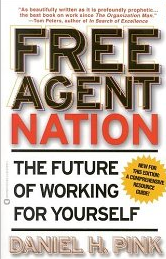 It is hard to believe that it has been nearly 10 years to the day since Free Agent Nation was published, and nearly 14 years since the article by Daniel Pink graced the cover of Fast Company magazine. Since that time, a lot has changed, but given the inflection point we are experiencing with regard to the economy, the job market, accelerating recruitment challenges, as well as changes in recruitment and candidate behaviors, it’s useful to revisit the free agent discussion in light of what has changed (and what has not).
It is hard to believe that it has been nearly 10 years to the day since Free Agent Nation was published, and nearly 14 years since the article by Daniel Pink graced the cover of Fast Company magazine. Since that time, a lot has changed, but given the inflection point we are experiencing with regard to the economy, the job market, accelerating recruitment challenges, as well as changes in recruitment and candidate behaviors, it’s useful to revisit the free agent discussion in light of what has changed (and what has not).
As I work with companies and talk with HR and talent acquisition executives, it is surprising that even today there remain deeply rooted social and organizational norms within even progressive companies regarding a concept of talent ownership.” It has been one of the more surprising artifacts I’ve observed in consulting: even now, organizations maintain a substantial amount of outdated, sometimes-unconscious thinking with regard to a concept that is clearly been eclipsed. This despite the fact that more companies are moving to an HR model of ‘end to end’ talent management. Many do not address some of the underlying organizational principles that need to change in order to compete in today’s New Talent Economy. The concept of talent ownership is one such example: many companies still insist on supporting regulation and rules-based HR policies to control for internal movement. A common example is restricting internal talent from applying for internal opportunities until they have been in their current job for x months. This is completely incongruent with the free-agent economy that exists today.
I’ve said many times, “If you are not recruiting your own people, you are the only company that isn’t…”
That has never been truer than today as social media has created innumerable entry points for recruiters and non-recruiters to reach people in your company. Yet company after company maintains policies that erode the concept of a laissez-faire talent economy internally. They restrict their own employees from changing jobs even as the world around them has evolved to be a free agent nation.
I do understand the practical implications of policies to balance the needs of individuals versus the broader needs of an organization. Clearly things don’t work well if workers are changing jobs every three months. So here are some ways to create programs that work in today’s talent economy.
- Create an internal talent marketplace: The talent marketplace outside of your company is becoming increasingly more efficient. For example, the “findability” of talent has never been easier. How is the talent marketplace inside of your firm? Many accounts suggest the process and approach to finding and landing a job inside of your company is more difficult than doing so outside of your company. If companies like Kayak are shortening their external recruiting process to seven days, how does your internal process stack up? Can internal talent sign up for new jobs to be delivered to their inbox? Is your process clearly communicated, concise, and have face-validity? If not, why not?
- If you must have term limits, change the structure of term limits: I’m a large fan of laissez-faire talent principle, but in practice, inside of an organization where hierarchy and structure and policies help drive efficiency at scale, they can be useful. So instead of enforcing term limits based on tenure, enforce term limits on the number of times people can move in a given period. Most companies set policies that require people to remain in roles for ~1 year before they can move. Which essentially suggests “we own you.” A smarter solution is to set guidelines that people can only move three times within an X year period. This provides flexibility while balancing the broader needs of the organization.
- Use social media internally: It’s obvious that recruiters are gaining leverage from social media. How are you doing so within your organization? Creating groups and tranching internal employees into segments makes sense. Do you have an internal social media strategy? Are you using tools like LinkedIn and Facebook to drive engagement and syndicate information (and human connection) across your organization. If not, why not?
As usual, sound off in the comments.